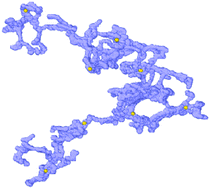A general phenomenological relation for the subdiffusive exponent of anomalous diffusion in disordered media
Abstract
This work numerically investigates the diffusion of finite inert tracer particles in different types of fixed gels. The mean square displacement (MSD) of the tracers reveals a transition to subdiffusive motion MSD ∼ tα as soon as the accessible volume fraction p in the gel decreases from unity. Individual tracer dynamics reveals two types of particles in the gels: mobile tracers cross the system through percolating pores following subdiffusive dynamics MSDmob ∼ tαmob, while a fraction ptrap(p) of the particles remain trapped in finite pores. Below the void percolation threshold p < pc all the particles get trapped and α → 0. By separately studying both populations we find a simple phenomenological law for the mobile tracers αmob(p) ≈ a ln p + c where c ≈ 1 and a ∼ 0.2 depends on the gel type. On the other hand, a cluster-analysis of the gel accessible volume reveals a power law for the trapping probability ptrap ∼ (p/pc)−γ, with γ ≃ 2.9. This yields a prediction for the ensemble averaged subdiffusion exponent α = αmob(1 − ptrap). Our predictions are successfully validated against the different gels studied here and against numerical and experimental results in the literature (silica gels, polyacrylamide gels, flexible F-actin networks and in different random obstacles). Notably, the parameter a ∼ 0.2 presents small differences amongst all these cases, indicating the robustness of the proposed relation.



 Please wait while we load your content...
Please wait while we load your content...